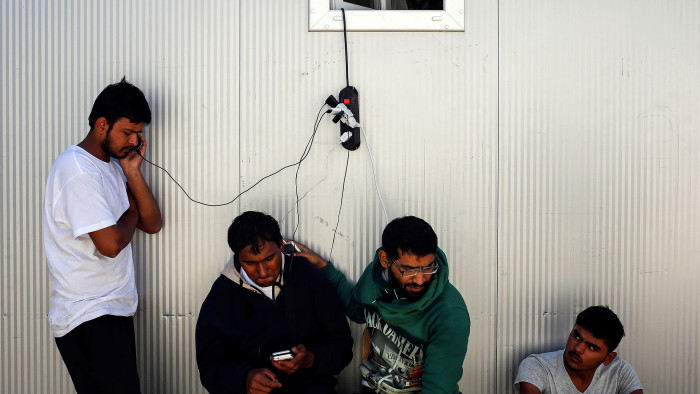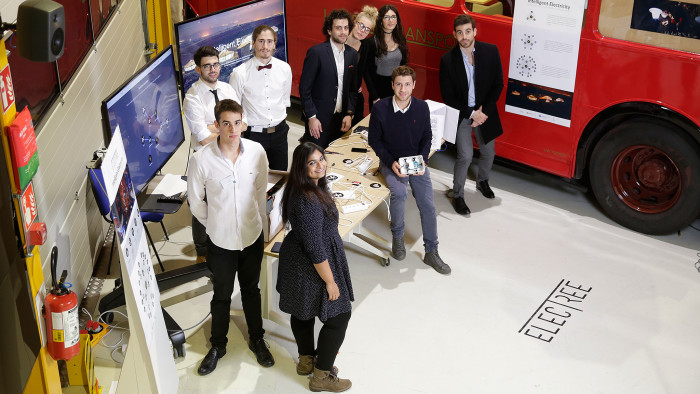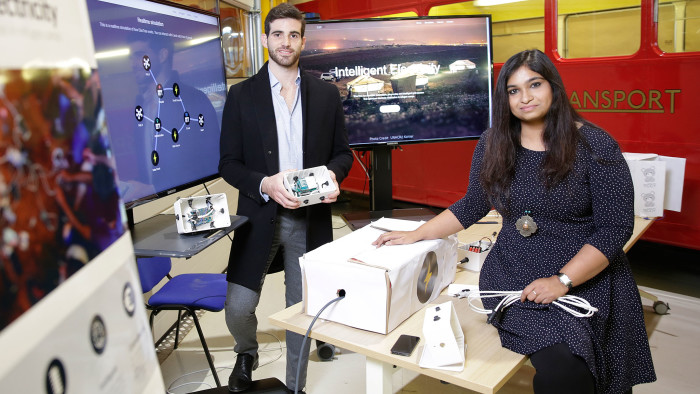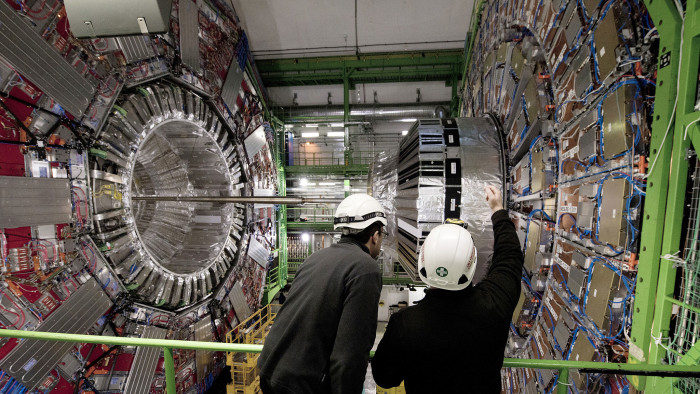MBA project at Cern develops device to bring electricity to refugees

Simply sign up to the Business education myFT Digest -- delivered directly to your inbox.
A team of students charged with improving the lives of displaced people found themselves debating an unlikely choice: should they develop an electricity grid to distribute scarce energy in refugee camps — or a teddy bear?
The nine students, from different countries, universities and disciplines, were part of a 12-week “challenge-based innovation” course created by Cern, the home of the Large Hadron Collider, near Geneva, and drawing on its scientists’ expertise.
The teddy bear, intended to give off a comforting glow, warmth and the smell of home to help traumatised refugee children, almost won. But eventually the group, which included MBA candidates from Barcelona’s Esade business school, aspiring designers from the city’s IED design school, as well as technical students from Italy and Spain, voted to develop a modular, expandable electricity grid.
The idea was to help refugee camps and emergency workers in disaster areas distribute power efficiently and equitably between communal facilities such as schools and hospitals, as well as individuals and families.
“We had big disagreements, but we were very democratic,” Argentine Esade student Iván Gabriel Leis recalls with a smile in December, when the group and other teams gather to polish and present their projects in the last of three stays at Cern.
Not far from where Leis and fellow Esade student Lalitha Kakulapati, from India, are talking, their teammates are explaining the merits of “ElecTree” to a group gathered around a prototype. The team has created a scalable product that is cheap to make and easy to use.

The students are sleep-deprived but excited. Global Humanitarian Labs, a partnership of organisations aiming to encourage and accelerate innovative ideas for the non-profit sector, has just offered to support them in turning the concept into a viable product ready for testing in the field.
This is the fourth time Cern had opened its facilities to a cohort of students for the scheme. The challenge-based innovation initiative is intended to help close a gap in Europe between scientific excellence and commercial application, while demonstrating that the billions of euros spent at Cern can produce socially useful technologies. (Many of the students’ ideas exploit the facility’s research, as the teddy bear was intended to.)
Until ElecTree, none of the student projects had been picked up by investors. But the business schools’ and universities’ main aim is to give students experience of working with different nationalities and across disciplines while developing a taste for innovation and entrepreneurship.
Some of the students chose the programme so they could work with Cern scientists. “I’m a nerd and just to come to Cern and work with these brilliant people here — I wasn’t going to pass up on that,” says Kakulapati.

The five teams were each given a broad challenge, for example: “improve the cognitive development and communication skills of people with disabilities”. The ElecTree team’s task was to use technology to “improve the living conditions of refugees, displaced and other people in need of emergency temporary sheltering”. The challenges are intentionally broad to give the students latitude to think big, says Markus Nordberg, head of the project at Cern.
The team’s mentor was Daniel Dobos, a scientist on the Atlas experiment, which made the groundbreaking discovery of the Higgs boson particle. The team’s first step was to research the challenge. Dobos connected them with Geneva-based humanitarian groups including the UN refugee agency UNHCR and the International Red Cross to discuss ideas throughout the process.
Lykke Groven, a Danish design student, flew to a refugee camp on the Greek island of Lesbos. She reported back on WhatsApp and introduced the team to a Syrian boy so traumatised by the war that he could not remember his name. “The toys that he had were really comforting him,” says Kakulapati. “This [teddy bear] idea suddenly came out of nowhere. We all loved it.”
The ElecTree proposal was prompted by one of the camp workers, who told Groven that while people had good ideas for improving sanitary conditions, health and education, none of these were possible without electricity.
“I think we all had that ‘aha’ moment when Lykke shared that,” says Leis.

Kakulapati remembered being caught in the earthquake in Nepal in April 2015. A hotel started up a generator for a few hours each evening so tourists and Nepalese could contact the outside world. With so many people struggling to get enough bandwidth to send an email, a system of sharing developed.
“When you are there in a time of need, the instinct is not to take. The instinct is to share,” Kakulapati says.
“I feel like that is something we brought to our prototype. It’s designed so that you divert energy to essential functions that everyone needs and the rest is shared.”
Some team members were reluctant to abandon the teddy bear idea but ultimately the group voted for the ElecTree proposal as the majority felt it would have a greater impact.
The students found that designers, engineers and business people view challenges in different ways and that working across disciplines was more demanding than overcoming cultural differences. Engineers are linear; they move from A to B, Kakulapati says. As for designers — she waves her hands above her head — designers go everywhere.
The two main concepts taught during the term are design thinking and lean start-up. The students explain this means that, starting with a broad challenge, they explore, research and narrow the focus. Then they go back to the users, test the ideas and finally develop a prototype.
Building the prototype exposed further differences in approach. Leis says that the engineers “had a sense not about the end-user, but about the technology. I didn’t have a sense of the limits of technology. The designers were saying ‘OK, but we need to help everyone’. We said, ‘You’re crazy’.” The team did not use Cern technology in the end, but the students say they learnt from the advice and thought processes instead.
Keeping costs low and making the grid simple to understand and use was essential. The design students produced a product brochure and PowerPoint presentation explaining how it works.
On the day of the final presentation, it is the business students who don suits to outline the concept. ElecTree, they explain, is a modular extendable intelligent grid that prioritises electricity needs for hospitals and schools, but recognises the requirements of refugees. So when administrative buildings and schools are not in use, the electricity flows more equitably to shelters.
Representatives of the non-governmental and UN agencies working with the groups are in the audience or watching a live webcast. With the other seven members sitting on a platform behind them, Leis and Kakulapati deliver polished pitches about ElecTree. Then, prompted by a question that they had planted in the audience, they get to present the teddy bear idea, too.
Comments